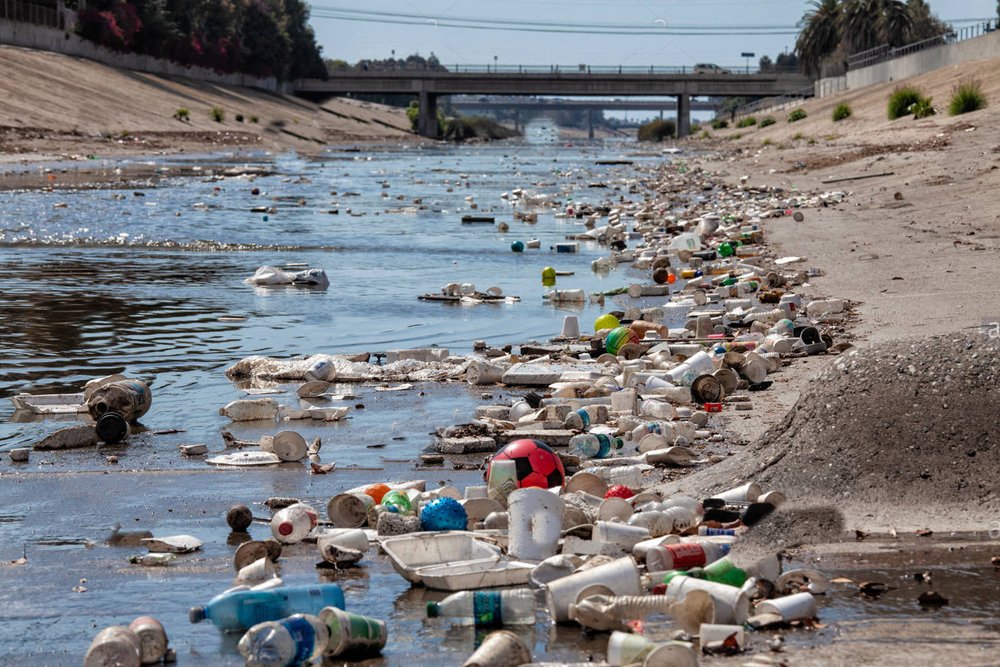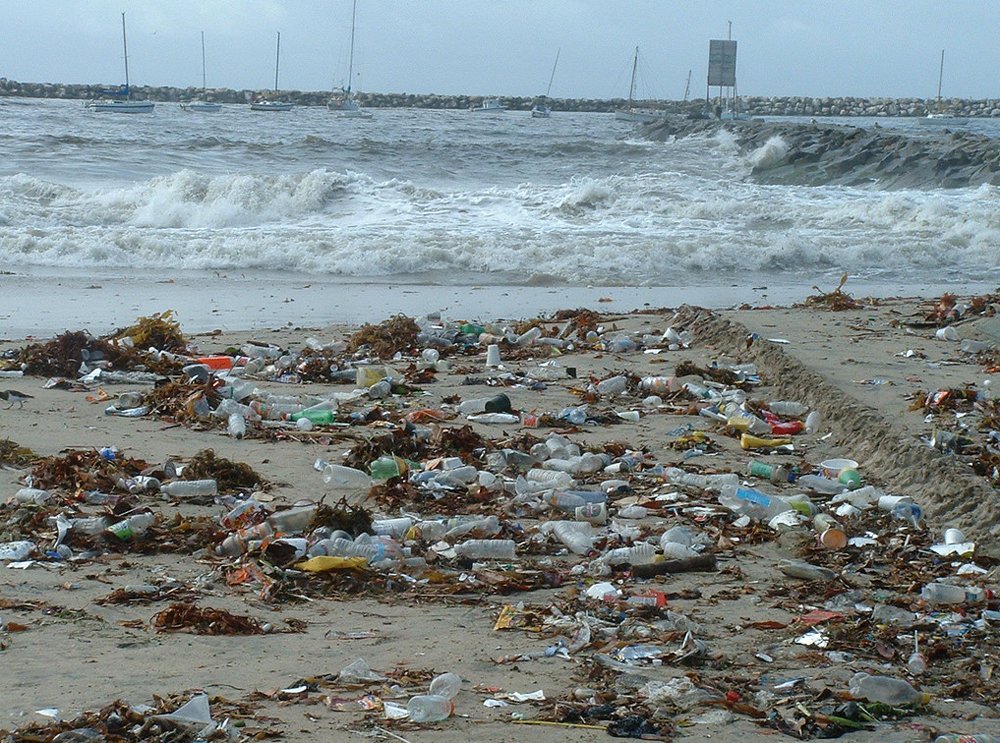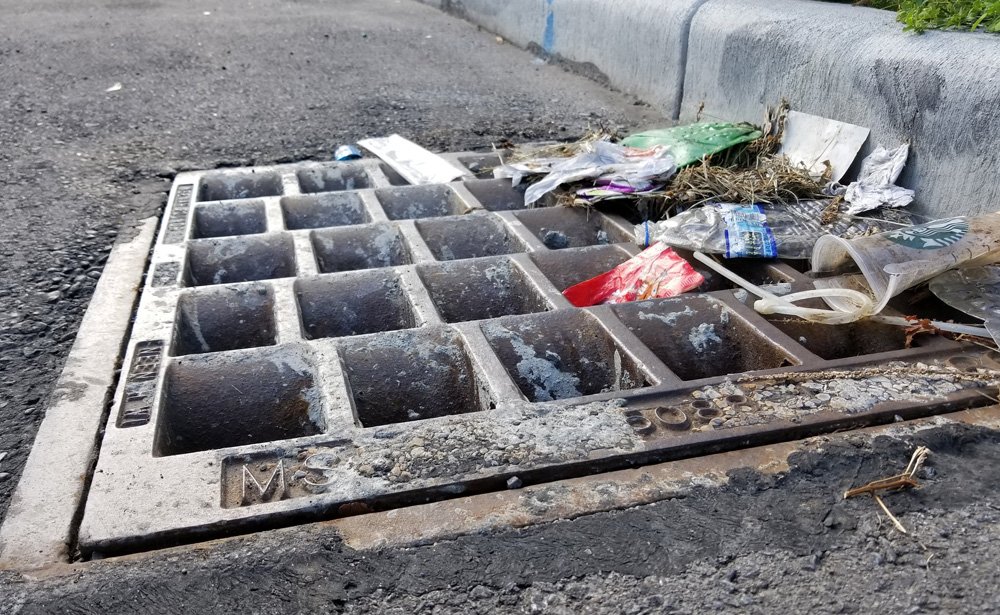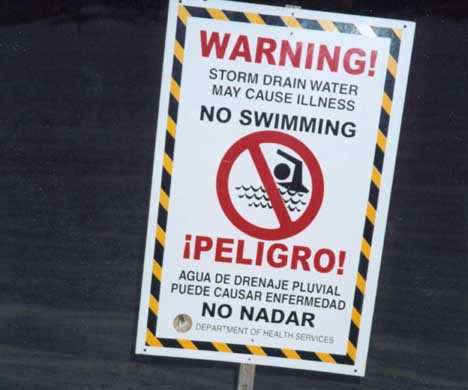Daily Chores Can Pollute Our Oceans
Washing cars. Watering lawns. Fertilizing gardens. Sweeping sidewalks. Every day, someone in the Santa Monica Bay area does one of these common chores around the house. Most of the water used to do some of these tasks runs down the driveway and into the gutter ends up in the storm drains.
 Unlike the sewer system connected to our toilets, storm drains don’t go to the sewage treatment plant. They flow to our beaches, depositing the water with all of the oils, pesticides, detergents, fertilizers, and trash it collects along the way straight into the oceans or into pools of dirty water at the mouth of the drain that small children often play in.
The result is that we end up surfing, swimming, fishing, and boating in the same stuff that we thought we were getting rid of.
According to local agency data, thousands of gallons of liquid go down the storm drains each day during dry conditions. When it rains, as hundreds of thousands of gallons rush through the storm drains to the ocean.
New Technology Helps Keep the Bay Clean
Fortunately, recent state funding pays for the installation of stormwater diversion systems. Simply put, these units connect the storm drains to the sewer systems, so that those oils, fertilizers, and other discarded materials we wash down our driveways are treated at the sewage plant and clean water is discharged to the ocean.
Unlike the sewer system connected to our toilets, storm drains don’t go to the sewage treatment plant. They flow to our beaches, depositing the water with all of the oils, pesticides, detergents, fertilizers, and trash it collects along the way straight into the oceans or into pools of dirty water at the mouth of the drain that small children often play in.
The result is that we end up surfing, swimming, fishing, and boating in the same stuff that we thought we were getting rid of.
According to local agency data, thousands of gallons of liquid go down the storm drains each day during dry conditions. When it rains, as hundreds of thousands of gallons rush through the storm drains to the ocean.
New Technology Helps Keep the Bay Clean
Fortunately, recent state funding pays for the installation of stormwater diversion systems. Simply put, these units connect the storm drains to the sewer systems, so that those oils, fertilizers, and other discarded materials we wash down our driveways are treated at the sewage plant and clean water is discharged to the ocean.
 But, these systems only work during dry weather days. When it rains, the additional volume of water rushing through the storm drains would overload the diversion units and harm the sewage treatment system. To avoid sewage backups into homes on rainy days, the storm drains are simply allowed to flow straight to the ocean untreated.
According to Mark Gold, Executive Director of Heal The Bay, the dry weather diversion systems have dramatically improved the ocean water quality in the Santa Monica Bay in recent years. “Beaches formerly receiving ‘Ds’ and ‘Fs’ are now receiving ‘As’ and ‘Bs’, says Gold. “While we haven’t solved the problem at some beaches, others such as those in Hermosa Beach, Manhattan Beach and state beaches farther north are much cleaner due to dry weather diversions. But, during rainy days, we still see high levels of harmful bacteria and chemicals flow to the ocean.”
But, these systems only work during dry weather days. When it rains, the additional volume of water rushing through the storm drains would overload the diversion units and harm the sewage treatment system. To avoid sewage backups into homes on rainy days, the storm drains are simply allowed to flow straight to the ocean untreated.
According to Mark Gold, Executive Director of Heal The Bay, the dry weather diversion systems have dramatically improved the ocean water quality in the Santa Monica Bay in recent years. “Beaches formerly receiving ‘Ds’ and ‘Fs’ are now receiving ‘As’ and ‘Bs’, says Gold. “While we haven’t solved the problem at some beaches, others such as those in Hermosa Beach, Manhattan Beach and state beaches farther north are much cleaner due to dry weather diversions. But, during rainy days, we still see high levels of harmful bacteria and chemicals flow to the ocean.”
 How to Help Keep the Bay Clean
How can we help? Proper disposal of trash, reducing the use of pesticides and fertilizers, picking up after our pets, and washing our cars at locations with special catch basins can vastly improve the water quality in our ocean. This will help ensure that it is safe for us to continue to swim, surf and play at the beach.
For more information, go to http://www.smbaykeeper.org
http://www.santamonicabay.org , http://www.lapublichealth.org/beach/, or http://www.healthebay.org
How to Help Keep the Bay Clean
How can we help? Proper disposal of trash, reducing the use of pesticides and fertilizers, picking up after our pets, and washing our cars at locations with special catch basins can vastly improve the water quality in our ocean. This will help ensure that it is safe for us to continue to swim, surf and play at the beach.
For more information, go to http://www.smbaykeeper.org
http://www.santamonicabay.org , http://www.lapublichealth.org/beach/, or http://www.healthebay.org
 Unlike the sewer system connected to our toilets, storm drains don’t go to the sewage treatment plant. They flow to our beaches, depositing the water with all of the oils, pesticides, detergents, fertilizers, and trash it collects along the way straight into the oceans or into pools of dirty water at the mouth of the drain that small children often play in.
The result is that we end up surfing, swimming, fishing, and boating in the same stuff that we thought we were getting rid of.
According to local agency data, thousands of gallons of liquid go down the storm drains each day during dry conditions. When it rains, as hundreds of thousands of gallons rush through the storm drains to the ocean.
New Technology Helps Keep the Bay Clean
Fortunately, recent state funding pays for the installation of stormwater diversion systems. Simply put, these units connect the storm drains to the sewer systems, so that those oils, fertilizers, and other discarded materials we wash down our driveways are treated at the sewage plant and clean water is discharged to the ocean.
Unlike the sewer system connected to our toilets, storm drains don’t go to the sewage treatment plant. They flow to our beaches, depositing the water with all of the oils, pesticides, detergents, fertilizers, and trash it collects along the way straight into the oceans or into pools of dirty water at the mouth of the drain that small children often play in.
The result is that we end up surfing, swimming, fishing, and boating in the same stuff that we thought we were getting rid of.
According to local agency data, thousands of gallons of liquid go down the storm drains each day during dry conditions. When it rains, as hundreds of thousands of gallons rush through the storm drains to the ocean.
New Technology Helps Keep the Bay Clean
Fortunately, recent state funding pays for the installation of stormwater diversion systems. Simply put, these units connect the storm drains to the sewer systems, so that those oils, fertilizers, and other discarded materials we wash down our driveways are treated at the sewage plant and clean water is discharged to the ocean.
 But, these systems only work during dry weather days. When it rains, the additional volume of water rushing through the storm drains would overload the diversion units and harm the sewage treatment system. To avoid sewage backups into homes on rainy days, the storm drains are simply allowed to flow straight to the ocean untreated.
According to Mark Gold, Executive Director of Heal The Bay, the dry weather diversion systems have dramatically improved the ocean water quality in the Santa Monica Bay in recent years. “Beaches formerly receiving ‘Ds’ and ‘Fs’ are now receiving ‘As’ and ‘Bs’, says Gold. “While we haven’t solved the problem at some beaches, others such as those in Hermosa Beach, Manhattan Beach and state beaches farther north are much cleaner due to dry weather diversions. But, during rainy days, we still see high levels of harmful bacteria and chemicals flow to the ocean.”
But, these systems only work during dry weather days. When it rains, the additional volume of water rushing through the storm drains would overload the diversion units and harm the sewage treatment system. To avoid sewage backups into homes on rainy days, the storm drains are simply allowed to flow straight to the ocean untreated.
According to Mark Gold, Executive Director of Heal The Bay, the dry weather diversion systems have dramatically improved the ocean water quality in the Santa Monica Bay in recent years. “Beaches formerly receiving ‘Ds’ and ‘Fs’ are now receiving ‘As’ and ‘Bs’, says Gold. “While we haven’t solved the problem at some beaches, others such as those in Hermosa Beach, Manhattan Beach and state beaches farther north are much cleaner due to dry weather diversions. But, during rainy days, we still see high levels of harmful bacteria and chemicals flow to the ocean.”
 How to Help Keep the Bay Clean
How can we help? Proper disposal of trash, reducing the use of pesticides and fertilizers, picking up after our pets, and washing our cars at locations with special catch basins can vastly improve the water quality in our ocean. This will help ensure that it is safe for us to continue to swim, surf and play at the beach.
For more information, go to http://www.smbaykeeper.org
http://www.santamonicabay.org , http://www.lapublichealth.org/beach/, or http://www.healthebay.org
How to Help Keep the Bay Clean
How can we help? Proper disposal of trash, reducing the use of pesticides and fertilizers, picking up after our pets, and washing our cars at locations with special catch basins can vastly improve the water quality in our ocean. This will help ensure that it is safe for us to continue to swim, surf and play at the beach.
For more information, go to http://www.smbaykeeper.org
http://www.santamonicabay.org , http://www.lapublichealth.org/beach/, or http://www.healthebay.org 
